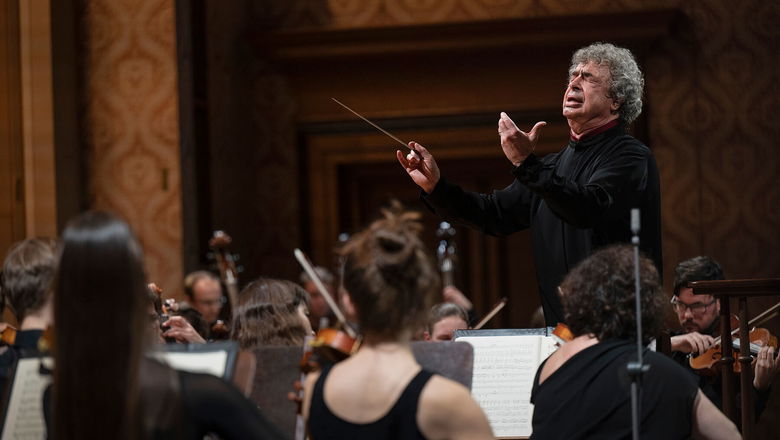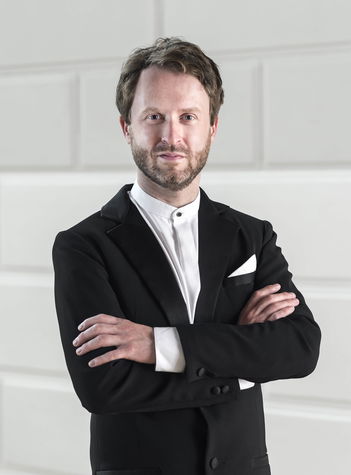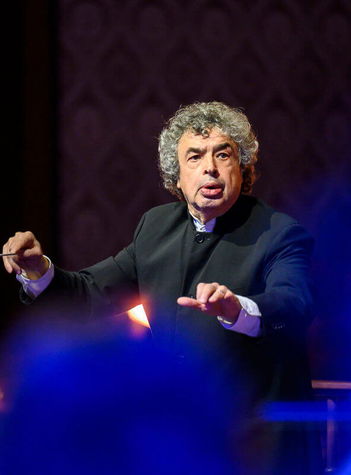Programme
Gustav Mahler
Symphony No. 3 in D minor (106')
Secure your seat for the 2025/2026 season – presales are open.
Choose SubscriptionIn our recording and concert plans for Mahler’s symphonies, the time has arrived for the Third Symphony—a work that includes voices and is the longest of all his symphonies. According to voting by the world’s top conductors, it is one of the ten greatest symphonies of all time. The solo part will be performed by mezzo-soprano Catriona Morison.
Subscription series A | Duration of the programme 1 hour 45 minutes
Gustav Mahler
Symphony No. 3 in D minor (106')
Christa Mayer mezzo-soprano
Catriona Morison mezzo-soprano
Prague Philharmonic Choir women’s choir
Lukáš Vasilek choirmaster
Pueri gaudentes boys’ choir
Jan Kyjovský, Libor Sládek choirmasters
Semyon Bychkov conductor
Czech Philharmonic

Catriona Morison mezzo-soprano

After having graduated from music school in Glasgow (Royal Conservatoire of Scotland), Berlin, and Weimar, the career of the Scottish mezzo-soprano Catriona Morison has been on the ascent step by step. She was a member of the opera studio in Weimar, then she won an engagement at the opera in Wuppertal, but the breakthrough of her career came in 2017 (at age 31), when she was the winner at the famed competition BBC Cardiff Singer of the World. Since then, we have been seeing her routinely on concert stages with famed orchestras such as the Cologne Philharmonic, the Orchestra of the Leipzig Gewandhaus, and the Elbephilharmonie and at the festivals in Edinburgh and Salzburg. She has also appeared at the BBC Proms. She has not forgotten about Wuppertal, however, where she recently sang the role of Nerone (The Coronation of Poppaea).
Her repertoire knows no limits, encompassing works from four centuries including contemporary music. For example, she gave the world premieres of This Frame is Part of the Painting by Errollyn Wallen and of the Prague Symphony by Detlev Glanert, with which she made her Czech Philharmonic debut two years ago. Last season, she stood in at the last moment for the ailing Christa Mayer in Mahler’s Third Symphony.
Prague Philharmonic Choir
The Prague Philharmonic Choir (PPC), founded in 1935 by the choirmaster Jan Kühn, is the oldest professional mixed choir in the Czech Republic. Their current choirmaster and artistic director is Lukáš Vasilek, and the second choirmaster is Lukáš Kozubík.
The choir has earned the highest acclaim in the oratorio and cantata repertoire, performing with the world’s most famous orchestras. In this country, they collaborate regularly with the Czech Philharmonic and the Prague Philharmonia. They also perform opera as the choir-in-residence of the opera festival in Bregenz, Austria.
Programmes focusing mainly on difficult, lesser-known works of the choral repertoire. For voice students, they are organising the Academy of Choral Singing, and for young children there is a cycle of educational concerts.
The choir has been honoured with the 2018 Classic Prague Award and the 2022 Antonín Dvořák Prize.
Lukáš Vasilek choirmaster

Lukáš Vasilek studied conducting and musicology. Since 2007, he has been the chief choirmaster of the Prague Philharmonic Choir (PPC). Most of his artistic work with the choir consists of rehearsing and performing the a cappella repertoire and preparing the choir to perform in large-scale cantatas, oratorios, and operatic projects, during which he collaborates with world-famous conductors and orchestras (such as the Berlin Philharmonic, the Czech Philharmonic, the Israel Philharmonic, and the Saint Petersburg Philharmonic).
Besides leading the PPC, he also engages in other artistic activities, especially in collaboration with the vocal ensemble Martinů Voices, which he founded in 2010. As a conductor or choirmaster, his name appears on a large number of recordings that the PPC have made for important international labels (Decca Classics, Supraphon); in recent years, he has been devoting himself systematically to the recording of Bohuslav Martinů’s choral music. His recordings have received extraordinary acclaim abroad and have earned honours including awards from the prestigious journals Gramophone, BBC Music Magazine, and Diapason.
Pueri gaudentes
Since their formation more than three decades ago, Pueri gaudentes have performed in Europe, Asia and the USA. The Czech boys’ choir have made three tours of Japan and received coveted accolades at music festivals in Belgium, Germany and Italy. Pueri gaudentes have made numerous recordings for radio and television, and also feature on many CDs. The choir have often collaborated with the State Opera in Prague. They have appeared at renowned festivals (Prague Spring, etc.), performing along with distinguished Czech singers, orchestras (Prague Philharmonia, among others) and choruses (Prague Philharmonic Choir, etc.). In 2019, Pueri gaudentes made a two-week tour of Sweden, Finland, Russia and Estonia, within which they won a competition in St Petersburg and sang at the choral music festival in Laulupidu, one of the world’s greatest events of its kind (their visit is captured on the Czech Television documentary Pueri gaudentes in Estonia). In 2019, they also performed at St Peter’s Basilica in the Vatican. Led by the chorus masters Libor Sládek and Jan Kyjovský, Pueri gaudentes are accompanied by the pianist Denisa Martínková.
Semyon Bychkov conductor

In addition to conducting at Prague’s Rudolfinum, Semyon Bychkov and the Czech Philharmonic in the 2023/2024 season, took the all Dvořák programmes to Korea and across Japan with three concerts at Tokyo’s famed Suntory Hall. In spring, an extensive European tour took the programmes to Spain, Austria, Germany, Belgium, and France and, at the end of year 2024, the Year of Czech Music culminated with three concerts at Carnegie Hall in New York.
Among the significant joint achievements of Semyon Bychkov and the Czech Philharmonic is the release of a 7-CD box set devoted to Tchaikovsky’s symphonic repertoire and a series of international residencies. In 2024, Semjon Byčkov with the Czech Philharmonic concentrated on recording Czech music – a CD was released with Bedřich Smetanaʼs My Homeland and Antonín Dvořákʼs last three symphonies and ouvertures.
Bychkovʼs repertoire spans four centuries. His highly anticipated performances are a unique combination of innate musicality and rigorous Russian pedagogy. In addition to guest engagements with the world’s major orchestras and opera houses, Bychkov holds honorary titles with the BBC Symphony Orchestra – with whom he appears annually at the BBC Proms – and the Royal Academy of Music, who awarded him an Honorary Doctorate in July 2022. Bychkov was named “Conductor of the Year” by the International Opera Awards in 2015 and, by Musical America in 2022.
Bychkov began recording in 1986 and released discs with the Berlin Philharmonic, Bavarian Radio, Royal Concertgebouw, Philharmonia Orchestra and London Philharmonic for Philips. Subsequently a series of benchmark recordings with WDR Symphony Orchestra Cologne featured Brahms, Mahler, Rachmaninov, Shostakovich, Strauss, Verdi, Glanert and Höller. Bychkov’s 1993 recording of Tchaikovsky’s Eugene Onegin with the Orchestre de Paris continues to win awards, most recently the Gramophone Collection 2021; Wagner’s Lohengrin was BBC Music Magazine’s Record of the Year (2010); and Schmidt’s Symphony No. 2 with the Vienna Philharmonic was BBC Music Magazine’s Record of the Month (2018).
Semyon Bychkov has one foot firmly in the culture of the East and the other in the West. Born in St Petersburg in 1952, he studied at the Leningrad Conservatory with the legendary Ilya Musin. Denied his prize of conducting the Leningrad Philharmonic, Bychkov emigrated to the United States in 1975 and, has lived in Europe since the mid-1980’s. In 1989, the same year he was named Music Director of the Orchestre de Paris, Bychkov returned to the former Soviet Union as the St Petersburg Philharmonic’s Principal Guest Conductor. He was appointed Chief Conductor of the WDR Symphony Orchestra (1997) and Chief Conductor of Dresden Semperoper (1998).
Gustav Mahler
Symphony No. 3 in D minor
When Gustav Mahler was finishing his First Symphony, he began the sketches for his Second, and while finishing the Second he began his Third. The creative process for taking vast works from the first sketches to the definitive orchestration always took a few years. However, lack of time was not the only reason for these overlaps. In every symphony, Mahler was building a single world, and at a certain phase, another world opened itself before him. Again while composing the Third Symphony, there was a moment when he got a glimpse into yet another world. The Third was originally to have had seven movements, but he ultimately saved the last movement for his Fourth Symphony. Even with “just” six movements, the Third turned out to be Mahler’s longest symphony.
In the history of the premieres and early performances of Mahler’s symphonies, and especially of the early ones, we find one condemnation after another; music critics in particular competed with each other in denigrating his music. When Gustav Mahler arrived on the scene, his quite different kind of musical expression elicited very intense reactions from some of the composer’s colleagues of the previous generation. Even Johannes Brahms, who had a friendly inclination towards Mahler and respected him as a conductor, regarded his younger colleague as the “king of the revolutionaries”, and he was truly horrified by the score of his Second Symphony. Certain conductors greatly contributed to the performing of Mahler’s music, but even they could not guarantee success for the innovative music. In those days, it was still relatively common for only some of the movements of a multi-movement work to be played at concerts, and Mahler disapproved. After all, he was building “entire worlds” in his symphonies. Although he regarded the practice as the mutilation of his works, he had to resign himself to such compromises. At the same time, he did all he could to have his compositions played in their entirety. Devastating reviews tormented Mahler, but they did not dissuade him from writing more works. In March 1896, he wrote to a friend: “You'll see: I shall not live to see my cause triumph! Everything I write is too strange and new to my listeners, who cannot establish contact with me.”
It was in this state of mind that Gustav Mahler wrote his Symphony No. 3 in D minor. He began work on the first sketches in 1893 while in his second year as chief conductor at the opera in Hamburg. His enormous conducting workload prevented him from concentrating on composing, but he was creating new music in his mind during every free moment. He jotted down sketches of his compositions during the theatre’s season and looked forward to summer, when he would again become a “holiday composer”. Concentrated work on the Third Symphony took up the two summer holidays of 1895 and 1896. Mahler had established a ritual for his summer composing, which he followed in this case as well, leaving the city after the theatre’s season had ended and heading for the Alps. In the summer of 1895 he stayed at the same site as in previous years, at an inn in Steinbach near Lake Attersee. Every morning at 6:30 he went to a little hut (which is still standing) that he had built between the inn and the lakeshore. In a tiny room, he had only a desk and a piano. In that small, isolated space, he could concentrate fully on his great works, and no one was permitted to disturb him. He would occasionally go out into the meadows or on a walk alone, but he would return to his hut immediately to write into his score whatever ideas he had come up with. He did not leave the hut until lunchtime.
In his new symphony, “Nature itself” was to speak, but not in the sense of imitation or tone painting. Mahler wanted to portray the act of creation in music. He later revealed to a friend how he himself was affected by the symphony’s first movement: “It is hardly music anymore, just the voice of nature: one shudders at this motionless, soulless material (I could have called this movement “What the rocks tell me”), from which, little by little, life frees itself and finally conquers, developing and differentiating step by step: flowers, animals, men, right up to the kingdom of the spirit and that of the angels.” Mahler originally gave the symphony’s six movements titles. For the first movement, he wrote: “Pan awakens: Summer marches in”, and for the second: “What the flowers of the field tell me”. He continued in the same fashion with names for the rest of the movements: movement III is a musical setting of what the animals of the forest told him, followed by mankind and angels. Finally, his inscription for the sixth movement was “What love tells me”.
Mahler later suppressed the movements’ programmatic titles, but he retained the content of his conception. The symphony’s first three movements are purely instrumental; the composer waits until the fourth movement to let the human voice be heard. The alto solo “O Mensch! gib Acht!” (O Man! Take heed!) to a text by Friedrich Nietzsche has a revelatory effect. Mahler’s indication in the score reads “Very slowly, misterioso, sempre ppp”. The fifth movement also employs the vocal element, but in a completely different manner. It opens with ringing bells and a boys’ choir singing “Bim, bam” in accordance with Mahler’s indications: “Cheerful in tempo and cheeky in expression”. A women’s choir and alto soloist join in, singing the text “There were three angels singing a sweet song” from Mahler’s favourite collection of folk poetry, The Youth’s Magic Horn. While the fifth movement is brisk and the shortest part of the symphony, in the final sixth movement the composer slows the music down to create a calm, heartfelt statement of optimism. About the finale, regarded by many as one of Mahler’s most beautiful movements, the composer wrote in a letter: “It is a summation of what I feel towards all creation, and that could not have been done without undergoing deeply painful mental processes that suddenly evaporate into blissful faith.”
The composer divided his six-movement symphony into two parts. The first part contains the unusually long first movement, and the second part consists of the second through the sixth movements. Mahler was worried about the unusual length of the whole work, but he was convinced that it did not contain even a single superfluous bar, and he had serious conceptual reasons for the first movement’s dimensions: “No one can imagine how strenuous it is to compose such a long movement, to keep it cohesive, and not lose control over it. But I needed it to serve as a base, like a colossal pillar, like the base of a pyramid that gets ever narrower, more transparent, and weaker in the subsequent movements.”
The public premiere of the Third Symphony took place on 9 March 1897 in Berlin in Mahler’s presence, but just as in the cases of his two previous symphonies, it was heard in an incomplete form. Three movements were played under the baton of the outstanding conductor Felix Weingartner: the second, third, and sixth. The public in the packed concert hall reacted immediately after each movement was finished. After the “Flowers” movement, the listeners reacted favourably, but their dissatisfaction increased with each succeeding movement. By the end the applause was completely drowned out by hissing. Mahler fared even worse in the press, where he was portrayed as a “tragicomic hero” with “no imagination whatsoever” or “a jokester of the worst calibre”. Exactly five years later, on 9 March 1902, Gustav Mahler and Alma Schindler were married at the Karlskirche, a baroque church in Vienna. At the end of May 1902, when Mahler was 41 years old, he left Vienna accompanied by the young Alma, just 22 at the time, and went to Krefeld, Germany, to conduct his Third Symphony in its full, six-movement version at an important contemporary music festival. He insisted on plenty of rehearsals, and he resisted the urging of the organisers to give the individual movements titles. Having had bad experiences with his previous symphonies, he knew the kinds of misunderstandings that could arise from an incorrectly interpreted “programme”. He had realised that his “artistry always expresses only that which cannot be expressed in words.” He added humorously: “Listeners cannot be helped. Each listener has to help himself by listening repeatedly and carefully studying the score. […] Fortunately, it is my calling to write music, and not to write about music.” When the Third Symphony was first heard in its entirety on 9 June 1902, it was an extraordinary event and a triumph for the composer. Alma Mahler recalled: “There was a huge outburst of cheers after the first part, and after each subsequent movement the listeners seemed to be more moved until the last part, when the public went into a real frenzy.” The composer-conductor was called back to the stage twelve times.
Today, Mahler’s Third Symphony is played in concert halls all around the world. Within it there is something extraordinary, in places even terrifying, as the composer himself wrote in a letter to the singer Anna von Mildenburg: “My symphony will be something the likes of which the world has never heard before! In it, Nature itself speaks, revealing secrets so profound that one perhaps only senses them in dreams! Let me tell you, there are some passages in it that almost frighten me. Sometimes I even ask myself whether it should have been written at all.”
In our recording and concert plans for Mahler’s symphonies, the time has arrived for the Third Symphony—a work that includes voices and is the longest of all his symphonies. According to voting by the world’s top conductors, it is one of the ten greatest symphonies of all time. The solo part will be performed by mezzo-soprano Catriona Morison.